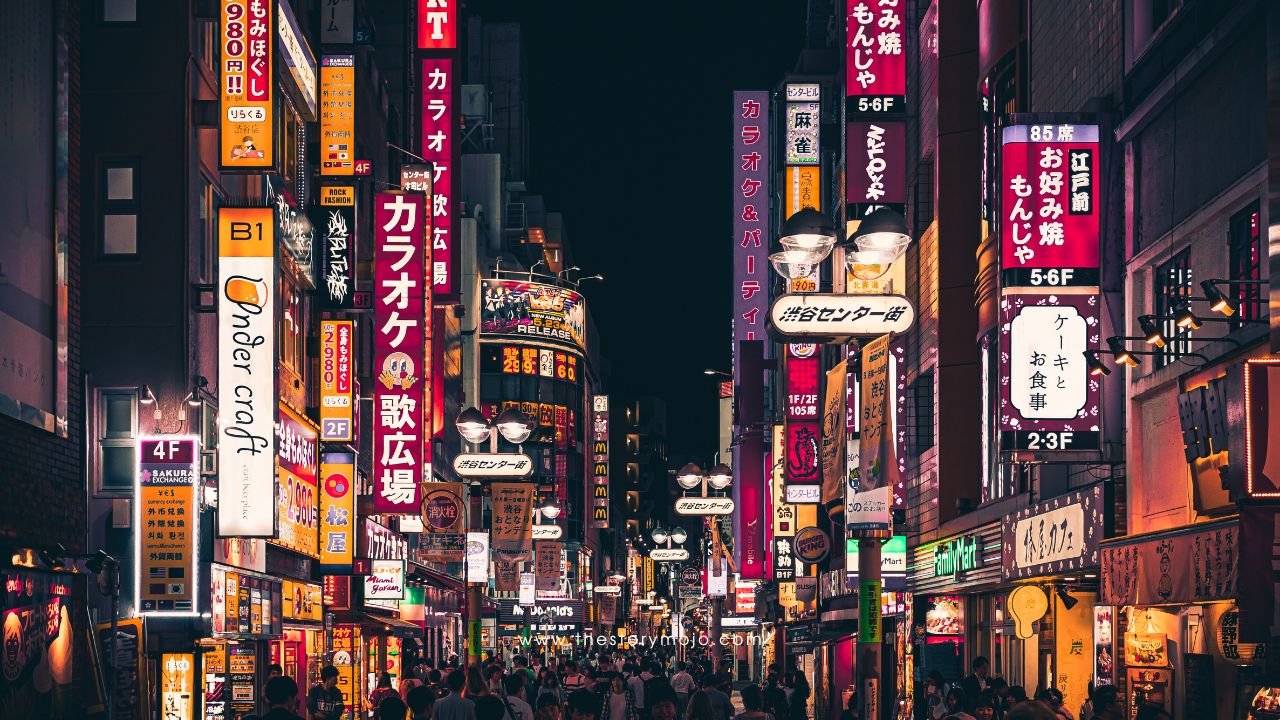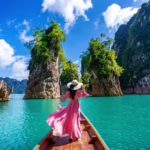
- arrow_back Home
- keyboard_arrow_right Things to do
Exploring Japan: A Comprehensive Guide for Malaysian Travelers
Things to doTravel 17 2 Andy March 2, 2025

Table of Contents
ToggleExploring Japan with The Story Mojo, a dream destination for many Malaysians,
offering a unique blend of ancient traditions and cutting-edge modernity. From bustling cities and serene temples to breathtaking natural landscapes and mouthwatering cuisine, Japan has something for everyone. Whether you’re a first-time visitor or a seasoned traveler, this guide will help you plan an unforgettable trip to Japan, tailored specifically for Malaysian travelers.

Top Things to Do in Japan
1. Explore Tokyo – The City of Contrasts
Tokyo, the bustling capital of Japan, is a city where ancient traditions and cutting-edge technology coexist harmoniously. From serene temples and lush gardens to neon-lit streets and futuristic attractions, Tokyo offers something for every traveler. Whether you’re a first-time visitor or a seasoned explorer, this vibrant metropolis promises an unforgettable experience.

Iconic Landmarks and Neighborhoods
Tokyo is a city of diverse neighborhoods, each with its own unique charm. In Shibuya, you can experience the world’s busiest pedestrian crossing and pay homage to the loyal Hachiko Statue. Shinjuku offers a mix of skyscrapers, entertainment districts, and tranquil gardens like Shinjuku Gyoen. In Asakusa, visit the historic Senso-ji Temple and stroll along Nakamise Street for traditional snacks and souvenirs. For a taste of youth culture, head to Harajuku, where Takeshita Street is lined with quirky fashion and colorful cafes. Don’t miss the serene Meiji Shrine nearby, a peaceful escape from the city’s hustle and bustle.
Cultural Experiences
Tokyo is a treasure trove of cultural experiences. Participate in a traditional tea ceremony to learn about the art of mindfulness and hospitality. Dress up in a kimono and explore historic districts like Asakusa or Yanaka for a unique photo opportunity. If you’re visiting during sumo season, catch a sumo wrestling match or visit a sumo stable to learn about this ancient sport.
Food and Dining
Tokyo is a food lover’s paradise, offering everything from street food to Michelin-starred restaurants. Savor fresh sushi and sashimi at Tsukiji Outer Market, slurp a bowl of rich ramen in Shinjuku, or indulge in crispy tempura at a specialty restaurant. For a casual dining experience, try yakitori (grilled chicken skewers) at an izakaya or sample street food like takoyaki (octopus balls) and taiyaki (fish-shaped pastries).
Shopping
Tokyo is a shopper’s dream, with options ranging from high-end boutiques to quirky street markets. In Ginza, you’ll find luxury brands and department stores, while Harajuku is perfect for trendy and quirky fashion. Akihabara is a haven for electronics and anime fans, and Don Quijote offers affordable souvenirs and snacks.
- Shibuya Crossing: Experience the world’s busiest pedestrian crossing, a symbol of Tokyo’s energy.
- Asakusa and Senso-ji Temple: Visit Tokyo’s oldest temple and explore Nakamise Street for traditional snacks and souvenirs.
- Harajuku: Discover quirky fashion and trendy cafes in this youthful district.
- Odaiba: Enjoy futuristic attractions like TeamLab Borderless and stunning views of Tokyo Bay.
- Tokyo Tower: Take in panoramic views of the city from this iconic landmark.
Tip for Malaysians: Use the Suica or Pasmo card for seamless travel on Tokyo’s public transport system.
2. Immerse Yourself in Kyoto’s Timeless Beauty
Kyoto, the former capital of Japan, is a city steeped in history, tradition, and natural beauty. Known for its well-preserved temples, serene gardens, and traditional tea houses, Kyoto offers a glimpse into Japan’s rich cultural heritage. Whether you’re a history buff, a nature lover, or a food enthusiast, Kyoto promises an unforgettable experience.

Iconic Temples and Shrines
Kyoto is home to over 1,000 temples and shrines, each with its own unique charm. The Kinkaku-ji(Golden Pavilion) is a must-visit, with its stunning gold-leaf exterior reflected in a tranquil pond. Fushimi Inari Taisha is famous for its thousands of red torii gates that form a mesmerizing pathway up the mountain. Another highlight is Kiyomizu-dera, a historic temple offering panoramic views of Kyoto and surrounded by cherry and maple trees.
Serene Gardens and Nature
Kyoto’s gardens are a testament to Japan’s love for nature and meticulous design. The Arashiyama Bamboo Grove is a magical place where towering bamboo stalks create a serene atmosphere. Nearby, the Tenryu-ji Temple features a beautiful Zen garden and is a UNESCO World Heritage Site. For a peaceful retreat, visit the Ryoan-ji rock garden, a masterpiece of minimalist design.
Cultural Experiences
Kyoto is the heart of Japanese culture, offering countless opportunities for immersive experiences. Participate in a traditional tea ceremony to learn about the art of mindfulness and hospitality. Dress up in a kimono and stroll through the historic Gion district, known for its traditional wooden machiya houses and geisha culture. If you’re visiting in spring or autumn, don’t miss the chance to see Kyoto’s famous cherry blossoms or fall foliage.
Food and Dining
Kyoto’s cuisine is a reflection of its cultural heritage, with an emphasis on seasonal ingredients and delicate flavors. Try kaiseki ryori, a traditional multi-course meal that showcases the best of Kyoto’s culinary artistry. For a more casual dining experience, enjoy yudofu (tofu hot pot) or matcha (green tea) sweets at a local café. Don’t forget to visit Nishiki Market, known as “Kyoto’s Kitchen,” for a variety of fresh produce, snacks, and souvenirs.
Tip for Malaysians: Wear comfortable shoes, as Kyoto’s temples often involve a lot of walking.
3. Experience Osaka’s Vibrant Energy
Osaka, Japan’s third-largest city, is a dynamic metropolis known for its lively atmosphere, delicious street food, and friendly locals. Often referred to as the “Kitchen of Japan,” Osaka is a food lover’s paradise, offering a wide array of culinary delights. Beyond its gastronomic appeal, the city boasts historic landmarks, modern attractions, and a vibrant nightlife, making it a must-visit destination for travelers.

Iconic Landmarks and Neighborhoods
Osaka is a city of contrasts, where ancient traditions meet modern innovation. Start your exploration at Osaka Castle, a historic landmark surrounded by beautiful gardens and offering panoramic views of the city. For a taste of Osaka’s vibrant energy, head to Dotonbori, a bustling district known for its neon lights, street food, and entertainment options. Don’t miss the iconic Glico Running Man sign, a popular photo spot.
Cultural Experiences
Osaka offers a variety of cultural experiences that showcase Japan’s rich heritage. Visit the Osaka Museum of History to learn about the city’s past, or explore the Sumiyoshi Taisha Shrine, one of Japan’s oldest Shinto shrines. For a unique experience, attend a bunraku (traditional puppet theater) performance, a UNESCO-recognized art form that originated in Osaka.
Food and Dining
Osaka is renowned for its culinary scene, with a focus on hearty and flavorful dishes. Must-try foods include takoyaki (octopus balls), okonomiyaki (savory pancakes), and kushikatsu (deep-fried skewers). For a more upscale dining experience, enjoy kaiseki ryori, a traditional multi-course meal that highlights seasonal ingredients. Don’t forget to visit Kuromon Ichiba Market, known as “Osaka’s Kitchen,” for a variety of fresh produce, seafood, and street food.
Modern Attractions
Osaka is home to several modern attractions that cater to all ages. Universal Studios Japan is a world-class theme park featuring attractions like Super Nintendo World and The Wizarding World of Harry Potter. For a futuristic experience, visit the Umeda Sky Building, where you can enjoy breathtaking views of the city from the Floating Garden Observatory. Another highlight is the Osaka Aquarium Kaiyukan, one of the largest aquariums in the world, showcasing a diverse range of marine life.
4. Discover the Natural Beauty of Hakone
Nestled in the Fuji-Hakone-Izu National Park, Hakone is a picturesque town known for its hot springs, stunning views of Mount Fuji, and rich cultural heritage. Just a short trip from Tokyo, Hakone offers a perfect escape from the city’s hustle and bustle, making it an ideal destination for nature lovers, history enthusiasts, and relaxation seekers.

Natural Beauty and Scenic Views
Hakone’s natural beauty is one of its biggest draws. The Hakone Ropeway provides breathtaking views of the surrounding mountains, including the iconic Mount Fuji on clear days. The ropeway takes you over the Owakudani Valley, known for its volcanic activity and sulfur vents. Don’t miss trying the local specialty, kuro-tamago (black eggs), said to add years to your life.
Another must-visit is Lake Ashi, a serene crater lake offering stunning views of Mount Fuji. Take a pirate ship cruise across the lake and visit the Hakone Shrine, famous for its red torii gate that stands majestically in the water.
Hot Springs and Relaxation
Hakone is renowned for its onsen (hot springs), which are perfect for relaxation and rejuvenation. The town boasts numerous ryokan (traditional inns) and public bathhouses where you can soak in mineral-rich waters while enjoying views of nature. Popular onsen areas include Gora, Yumoto, and Tenzan Tohji-kyo.
Cultural and Historical Attractions
Hakone offers a variety of cultural and historical attractions that showcase Japan’s rich heritage. The Hakone Open-Air Museum is a unique outdoor art museum featuring sculptures and installations set against a backdrop of mountains and forests. Another highlight is the Hakone Checkpoint Museum, which provides insights into the Edo period’s travel restrictions and samurai culture.
For a spiritual experience, visit the Choan-ji Temple, a serene Zen temple surrounded by lush greenery. The temple is particularly beautiful during the autumn foliage season.
Outdoor Activities
Hakone is a paradise for outdoor enthusiasts, offering a range of activities to suit all interests. Hiking trails like the Old Tokaido Road and the Hakone Komagatake Ropeway provide opportunities to explore the area’s natural beauty. For a more leisurely experience, take a stroll through the Hakone Botanical Garden of Wetlands, which features a variety of plant species native to wetland environments.
Food and Dining
Hakone’s cuisine is a reflection of its natural surroundings, with an emphasis on fresh, local ingredients. Enjoy a traditional kaiseki meal at a ryokan, where each dish is carefully prepared to highlight seasonal flavors. For a more casual dining experience, try soba (buckwheat noodles) or yuba (tofu skin), a local specialty.
Tip for Malaysians: Pack a small towel and be prepared to follow onsen etiquette, such as washing before entering the bath.
5. Visit Hiroshima and Miyajima
Hiroshima and Miyajima, located in Japan’s Chugoku region, offer a unique blend of historical significance and natural beauty. While Hiroshima is known for its poignant history and message of peace, Miyajima is celebrated for its serene landscapes and iconic shrines. Together, these destinations provide a deeply moving and enriching travel experience.
Hiroshima: A City of Peace

Peace Memorial Park
Hiroshima’s Peace Memorial Park is a must-visit, serving as a powerful reminder of the city’s tragic past and its commitment to peace. Key sites within the park include:
- Atomic Bomb Dome: A UNESCO World Heritage Site, this preserved building stands as a stark symbol of the atomic bombing in 1945.
- Peace Memorial Museum: Offers a comprehensive look at the events of the bombing and its aftermath, emphasizing the importance of peace and nuclear disarmament.
- Children’s Peace Monument: Dedicated to the young victims of the bombing, particularly Sadako Sasaki, who folded paper cranes in hopes of recovery.
Hiroshima Castle
Also known as the “Carp Castle,” Hiroshima Castle is a reconstructed fortress that offers insights into Japan’s feudal history. The castle grounds are particularly beautiful during cherry blossom season.
Shukkeien Garden
This traditional Japanese garden features a central pond, teahouses, and meticulously landscaped greenery, providing a peaceful retreat in the heart of the city.
Miyajima: The Island of the Gods

Itsukushima Shrine
Miyajima is famous for the Itsukushima Shrine, a UNESCO World Heritage Site known for its “floating” torii gate. During high tide, the gate appears to float on the water, creating a breathtaking scene. The shrine itself is a masterpiece of Shinto architecture, with its vermilion structures blending harmoniously with the natural surroundings.
Mount Misen
For nature enthusiasts, a hike up Mount Misen offers stunning views of the Seto Inland Sea. The mountain is also home to several temples and the Daisho-in Temple, a significant Buddhist site with a variety of religious artifacts and statues.
Miyajima’s Deer
Similar to Nara, Miyajima is home to friendly deer that roam freely around the island. These gentle creatures add to the island’s charm and are a delight for visitors.
Cultural Experiences
Hiroshima-style Okonomiyaki
Hiroshima is famous for its version of okonomiyaki, a savory pancake layered with noodles, cabbage, and various toppings. Try this local delicacy at Okonomimura, a multi-story building dedicated to the dish.
Momiji Manju
Miyajima is known for momiji manju, a maple leaf-shaped cake filled with sweet red bean paste or other flavors like chocolate and custard. These make for perfect souvenirs.
Tip for Malaysians: Take a moment to reflect on the resilience and peace symbolized by Hiroshima’s memorials.
6. Explore the Snowy Wonderland of Hokkaido
Hokkaido, Japan’s northernmost island, is a haven for nature lovers, food enthusiasts, and adventure seekers. Known for its stunning landscapes, vibrant cities, and unique culture, Hokkaido offers a diverse range of experiences that make it a must-visit destination. Whether you’re exploring its snowy wonderlands in winter or its lush fields in summer, Hokkaido promises an unforgettable adventure.

Natural Beauty and Outdoor Activities
Sapporo
Hokkaido’s capital, Sapporo, is a vibrant city known for its beer, ramen, and the annual Sapporo Snow Festival. Visit the Sapporo Beer Museum to learn about the history of beer in Japan, and enjoy a fresh brew at the adjacent beer garden. The Odori Park is a great place to relax and offers stunning views of the city.
Furano and Biei
Furano and Biei are famous for their picturesque landscapes. In summer, the lavender fields of Furano are a sight to behold, while Biei’s rolling hills and flower fields offer endless photo opportunities. Don’t miss the Blue Pond, a stunning man-made pond with vibrant blue waters.
Shikotsu-Toya National Park
This national park is home to Lake Toya and Lake Shikotsu, both offering breathtaking views and outdoor activities like hiking, boating, and hot springs. The park is also known for its active volcanoes, including Mount Usu and Showa Shinzan.
Daisetsuzan National Park
Japan’s largest national park, Daisetsuzan, is a paradise for hikers and nature lovers. The park features rugged mountains, hot springs, and diverse wildlife. The Asahidake Ropeway offers stunning views of the park’s highest peak, Mount Asahi.
Winter Wonderland
Niseko
Niseko is one of Japan’s premier ski destinations, known for its powdery snow and excellent ski resorts. Whether you’re a beginner or an expert, Niseko offers slopes for all skill levels. After a day on the slopes, relax in one of the many hot springs in the area.
Asahikawa
Asahikawa is another popular winter destination, home to the Asahiyama Zoo, which is famous for its penguin parade. The city also hosts the Asahikawa Winter Festival, featuring impressive ice sculptures and winter activities.
Food and Dining
Hokkaido is a food lover’s paradise, offering a variety of fresh and delicious dishes. Must-try foods include:
- Seafood: Hokkaido is known for its fresh seafood, particularly crab, scallops, and sea urchin. Visit the Nijo Market in Sapporo for a seafood feast.
- Ramen: Sapporo is famous for its miso ramen, a rich and flavorful noodle soup.
- Dairy Products: Hokkaido’s dairy products, including milk, cheese, and ice cream, are renowned for their quality and taste.
- Genghis Khan: A local specialty, this dish features grilled lamb and vegetables, often enjoyed at a jingisukan restaurant.
Cultural Experiences
Ainu Culture
The Ainu are the indigenous people of Hokkaido, and their culture is an integral part of the island’s heritage. Visit the Upopoy National Ainu Museum and Park in Shiraoi to learn about Ainu history, traditions, and crafts.
Onsen
Hokkaido is home to numerous hot springs, offering a relaxing way to unwind after a day of exploration. Popular onsen towns include Noboribetsu, known for its therapeutic waters, and Jozankei, a scenic hot spring resort near Sapporo.
Tip for Malaysians: If visiting in winter, pack warm clothing and layers to stay comfortable in the cold.
7. Relax in Okinawa’s Tropical Paradise
Okinawa, a chain of islands in southern Japan, offers a unique blend of tropical beauty, rich history, and distinct culture. Known for its pristine beaches, crystal-clear waters, and warm climate, Okinawa is a perfect destination for those seeking relaxation, adventure, and a glimpse into Japan’s Ryukyu heritage. Whether you’re exploring its vibrant coral reefs or delving into its historical sites, Okinawa promises an unforgettable experience.

Natural Beauty and Outdoor Activities
Beaches and Marine Life
Okinawa is renowned for its stunning beaches and vibrant marine life. Zamami Island and Tokashiki Island, part of the Kerama Islands, offer some of the best snorkeling and diving spots, with opportunities to see colorful coral reefs and tropical fish. Manza Beach and Emerald Beach are also popular for their clear waters and white sand.
Ishigaki Island
Located in the Yaeyama Islands, Ishigaki is a paradise for nature lovers. Kabira Bay is famous for its emerald-green waters and glass-bottom boat tours, while Mount Nosoko offers hiking trails with panoramic views of the island.
Iriomote Island
For adventure seekers, Iriomote Island is a must-visit. The island is covered in dense jungle and offers activities like kayaking, jungle trekking, and exploring waterfalls such as Pinaisara Falls.
Cultural and Historical Attractions
Shuri Castle
A UNESCO World Heritage Site, Shuri Castle in Naha was the royal palace of the Ryukyu Kingdom. Although parts of the castle were destroyed in a fire in 2019, restoration efforts are ongoing, and the site remains a significant cultural landmark.
Okinawa World
This cultural theme park offers a glimpse into Okinawa’s traditions and history. Explore the Gyokusendo Cave, one of Japan’s largest limestone caves, and visit the Habu Park to learn about the local wildlife. The park also features traditional Ryukyu houses and cultural performances.
Peace Memorial Park
Located in Itoman, the Peace Memorial Park commemorates the Battle of Okinawa during World War II. The park includes a museum, monuments, and the Cornerstone of Peace, which lists the names of all those who lost their lives in the battle.
Food and Dining
Okinawa’s cuisine is distinct from mainland Japan, with influences from Chinese and Southeast Asian flavors. Must-try dishes include:
- Goya Champuru: A stir-fry dish made with bitter melon, tofu, and eggs.
- Okinawa Soba: A noodle dish made with wheat flour, served in a savory broth with pork and green onions.
- Rafute: Slow-cooked pork belly, tender and flavorful.
- Taco Rice: A fusion dish featuring taco-style ingredients served over rice.
Don’t forget to try Awamori, a traditional Okinawan distilled spirit, and Beniimo Tart, a sweet purple potato dessert.
Tip for Malaysians: Okinawa’s laid-back vibe and warm weather make it a great destination for relaxation.
Japanese Cuisine: A Foodie’s Paradise
- Sushi and Sashimi: Enjoy fresh seafood at Tsukiji Market in Tokyo or Nishiki Market in Kyoto.
- Ramen: Try regional varieties like miso ramen in Sapporo or tonkotsu ramen in Fukuoka.
- Tempura: Savor crispy, lightly battered seafood and vegetables.
- Wagyu Beef: Indulge in high-quality Japanese beef, such as Kobe or Matsusaka beef.
- Street Food: Sample takoyaki, okonomiyaki, and taiyaki (fish-shaped pastries).
Tip for Malaysians: Many restaurants display plastic food models, making it easier to order even if you don’t speak Japanese.
Video Credit: Inaka Adventure
Itinerary for Malaysian Travelers with Approximate Cost
7-Day Itinerary
- Day 1-3: Tokyo (Shibuya, Asakusa, Harajuku, Odaiba)
- Day 4: Hakone (Mount Fuji views, Lake Ashi, onsen)
- Day 5-6: Kyoto (Kinkaku-ji, Fushimi Inari, Arashiyama)
- Day 7: Osaka (Dotonbori, Osaka Castle, Universal Studios Japan)
10-Day Itinerary
- Day 1-3: Tokyo
- Day 4: Nikko (Toshogu Shrine, Kegon Falls)
- Day 5-6: Kyoto
- Day 7: Nara (Todai-ji, Nara Park)
- Day 8-9: Osaka
- Day 10: Hiroshima and Miyajima
1. Flights
- Round-trip flight (Kuala Lumpur to Tokyo): RM 1,500 – RM 2,500 (depending on the airline and booking time).
2. Accommodation
- Tokyo (3 nights): RM 300 – RM 500 per night for a mid-range hotel = RM 900 – RM 1,500.
- Hakone (1 night): RM 400 – RM 700 for a ryokan (traditional inn) with onsen and dinner.
- Kyoto (2 nights): RM 300 – RM 500 per night = RM 600 – RM 1,000.
- Osaka (1 night): RM 300 – RM 500 per night.
Total Accommodation: RM 2,200 – RM 3,700.
3. Transportation
- Japan Rail Pass (7 days): RM 1,100 (covers Shinkansen, JR trains, and some local transport).
- Local transport (subways, buses): RM 200 – RM 300.
Total Transportation: RM 1,300 – RM 1,400.
4. Food
- Average daily food budget: RM 100 – RM 150 per day (mid-range meals, including street food and casual dining).
- Total for 7 days: RM 700 – RM 1,050.
5. Activities and Attractions
- Tokyo attractions (e.g., Tokyo Tower, TeamLab Borderless): RM 200 – RM 300.
- Hakone attractions (e.g., Hakone Ropeway, Open-Air Museum): RM 150 – RM 200.
- Kyoto attractions (e.g., Kinkaku-ji, Fushimi Inari): RM 100 – RM 150.
- Osaka attractions (e.g., Osaka Castle, Dotonbori): RM 100 – RM 150.
Total Activities: RM 550 – RM 800.
6. Miscellaneous (Souvenirs, Snacks, etc.)
- Budget: RM 300 – RM 500.
Total Estimated Cost for 7-Day Itinerary
- Low Range: RM 6,050 (budget-friendly options).
- Mid Range: RM 7,500 – RM 8,500 (comfortable mid-range travel).
- High Range: RM 9,500+ (luxury options).
10-Day Itinerary: Tokyo, Nikko, Kyoto, Nara, Osaka, Hiroshima, and Miyajima
1. Flights
- Round-trip flight (Kuala Lumpur to Tokyo): RM 1,500 – RM 2,500.
2. Accommodation
- Tokyo (3 nights): RM 300 – RM 500 per night = RM 900 – RM 1,500.
- Nikko (1 night): RM 300 – RM 500 per night.
- Kyoto (3 nights): RM 300 – RM 500 per night = RM 900 – RM 1,500.
- Osaka (2 nights): RM 300 – RM 500 per night = RM 600 – RM 1,000.
- Hiroshima (1 night): RM 300 – RM 500 per night.
Total Accommodation: RM 3,000 – RM 5,000.
3. Transportation
- Japan Rail Pass (14 days): RM 1,600 (covers Shinkansen, JR trains, and some local transport).
- Local transport (subways, buses): RM 300 – RM 400.
Total Transportation: RM 1,900 – RM 2,000.
4. Food
- Average daily food budget: RM 100 – RM 150 per day.
- Total for 10 days: RM 1,000 – RM 1,500.
5. Activities and Attractions
- Tokyo attractions: RM 200 – RM 300.
- Nikko attractions (e.g., Toshogu Shrine, Kegon Falls): RM 100 – RM 150.
- Kyoto attractions: RM 150 – RM 200.
- Nara attractions (e.g., Todai-ji, Nara Park): RM 50 – RM 100.
- Osaka attractions: RM 100 – RM 150.
- Hiroshima and Miyajima attractions (e.g., Peace Memorial Park, Itsukushima Shrine): RM 100 – RM 150.
Total Activities: RM 700 – RM 1,050.
6. Miscellaneous (Souvenirs, Snacks, etc.)
- Budget: RM 500 – RM 700.
Total Estimated Cost for 10-Day Itinerary
- Low Range: RM 8,600 (budget-friendly options).
- Mid Range: RM 10,000 – RM 11,500 (comfortable mid-range travel).
- High Range: RM 13,000+ (luxury options).
Tips to Save Money
- Book Flights Early: Airfare is often cheaper when booked 3-6 months in advance.
- Use the Japan Rail Pass: It’s cost-effective for long-distance travel, especially for itineraries covering multiple cities.
- Stay in Budget Accommodations: Consider hostels, guesthouses, or business hotels to save on lodging.
- Eat Like a Local: Enjoy affordable meals at convenience stores, ramen shops, and street food stalls.
- Visit Free Attractions: Many temples, parks, and shrines are free or have minimal entrance fees.
Tips for Malaysian Travelers
- Visa Requirements: Malaysians do not need a visa for short stays (up to 90 days).
- Currency: The currency is the Japanese Yen (JPY). Credit cards are widely accepted, but carry cash for smaller establishments.
- Language: Learn basic Japanese phrases or use translation apps. Most signs are in English.
- Transport: Get a Japan Rail Pass for unlimited travel on JR trains, including the Shinkansen.
- Etiquette: Follow Japanese customs, such as bowing, removing shoes indoors, and not tipping.
- Weather: Pack according to the season. Summers can be hot and humid, while winters are cold, especially in Hokkaido.
A trip to Japan is a worthwhile investment, offering unforgettable experiences and memories. For Malaysian travelers, the approximate cost of a 7-day itinerary ranges from RM 6,000 to RM 9,500, while a 10-day itinerary ranges from RM 8,600 to RM 13,000, depending on your travel style and preferences. By planning ahead and making smart choices, you can enjoy Japan’s wonders without breaking the bank. Selamat jalan! (Safe travels!)
©2025 thestorymojo.com All rights reserved.






Pingback:
8 Serene Cherry Blossom Spots in Tokyo You Must Visit
Pingback:
Exciting Growth: Malaysia Ranks 2nd in Car Ownership